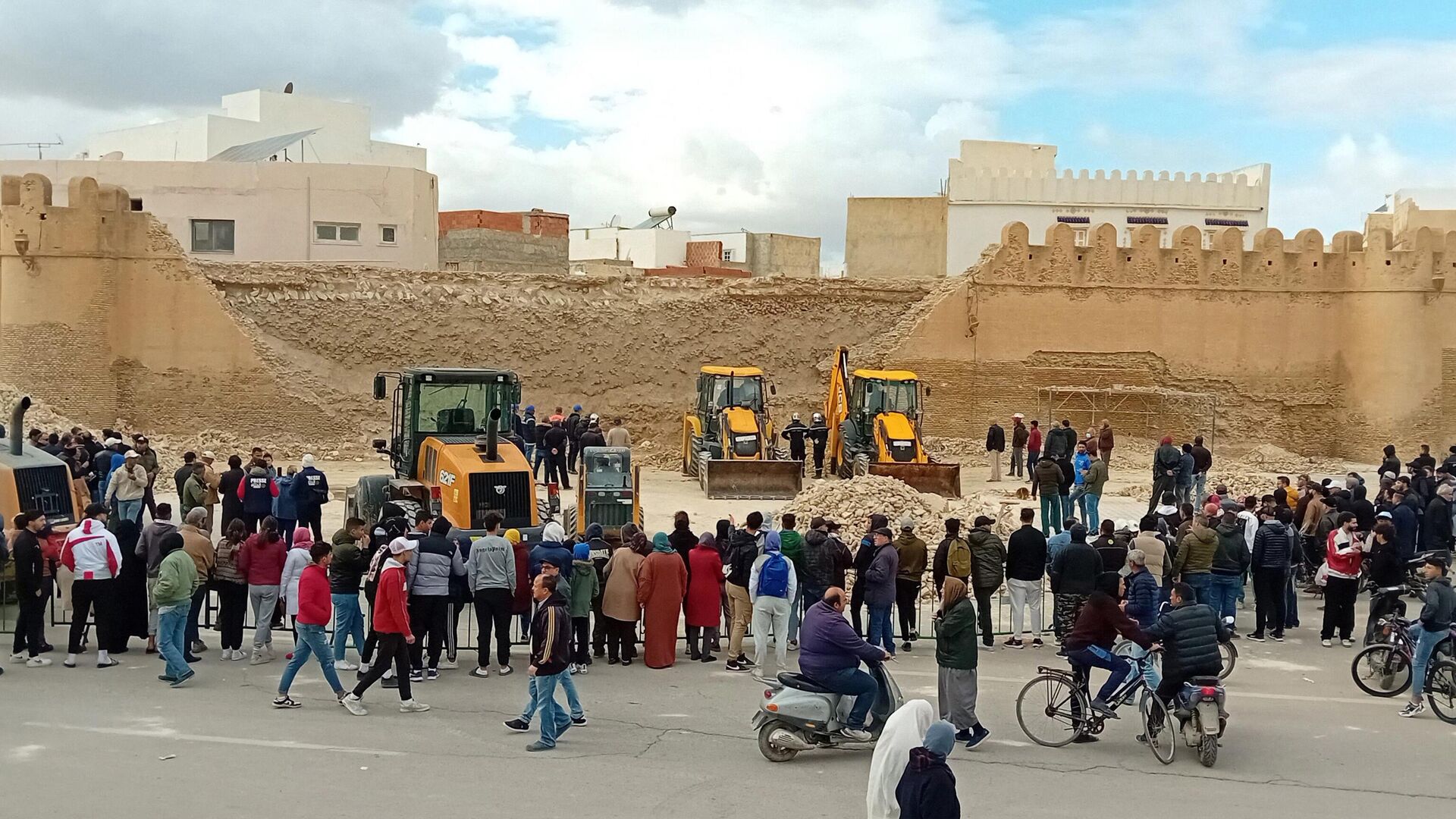https://en.sputniknews.africa/20231217/three-workers-killed-in-wall-collapse-at-unesco-world-heritage-site-in-tunisia-reports-say-1064166339.html
Three Workers Killed in Wall Collapse at UNESCO World Heritage Site in Tunisia, Reports Say
Three Workers Killed in Wall Collapse at UNESCO World Heritage Site in Tunisia, Reports Say
Sputnik Africa
The Tunisian city of Kairouan was founded in 670 AD by Uqba ibn Nafi, who was a military leader and statesman of the Rashidun and Umayyad Caliphates. Kairouan... 17.12.2023, Sputnik Africa
2023-12-17T15:42+0100
2023-12-17T15:42+0100
2023-12-17T17:06+0100
tunisia
north africa
unesco
maghreb
building collapse
death
https://cdn1.img.sputniknews.africa/img/07e7/0c/11/1064167646_0:160:3072:1888_1920x0_80_0_0_fc646db96fa0d0369b737923a1bf8237.jpg
A collapse of a section of the ancient walls encircling the Old City of Kairouan claimed the lives of three masons on Saturday who were repairing the UNESCO World Heritage Site, Tunisian authorities reportedly said.Two other workers were also injured when a 30-meter section of the 6-meter-tall walls collapsed to the ground near the Gate of the Floggers, according to the Civil Protection Department, the media reported.A group was performing restoration work on the three-kilometer-long wall that encircles the Old City, Moez Tria, a spokesman for the department, told the media. Tria added that recent excessive rainfall in the area could have contributed to the accident.Furthermore, the spokesman stated that a perimeter had been set up to prevent anybody from passing beneath a section of the wall that remains susceptible to additional collapse.Cultural Significance of KairouanKairouan city, established in 670 AD, is situated in the heart of Tunisia and holds great religious significance in North Africa. It is also a prominent destination for tourists.The city was part of the Islamic Caliphate during the Middle Ages: the Rashidun Caliphate (632–661), which succeeded the first Caliphate founded by Prophet Muhammad himself in what is now Saudi Arabia, and expanded widely in the Middle East and North Africa, the Umayyad Caliphate (661–750), and the Abbasid Caliphate (750–1258).During the medieval period, three major caliphates succeeded each other: the Rashidun Caliphate (632–661), the Umayyad Caliphate (661–750), and the Abbasid Caliphate (750–1258).The city boasts a wealth of architectural treasures, including the Great Mosque, adorned with exquisite marble and porphyry columns, as well as the 9th-century Mosque of the Three Gates.Since 1988, Kairouan has been recognized as a UNESCO World Heritage Site. The oldest known mosque with a sculpted facade — the Mosque of the Three Doors — is located there.For a span of four centuries, the city held the prestigious title of being the capital of the Muslim world in North Africa, until it was replaced by Tunis as the political capital of Tunisia in the 12th century.UNESCO described the mosque as "an architectural masterpiece that served as a model for several other mosques in the Maghreb." Moreover, according to the organization, "Kairouan bears unique witness to the first centuries of this civilization and its architectural and urban development."
https://en.sputniknews.africa/20230724/1060735664.html
tunisia
north africa
maghreb
Sputnik Africa
feedback@sputniknews.com
+74956456601
MIA „Rossiya Segodnya“
2023
Christina Glazkova
https://cdn1.img.sputniknews.africa/img/07e7/0b/07/1063380906_0:0:673:674_100x100_80_0_0_79628b4d0cd9f29291a57aa13bbf9e7a.jpg
Christina Glazkova
https://cdn1.img.sputniknews.africa/img/07e7/0b/07/1063380906_0:0:673:674_100x100_80_0_0_79628b4d0cd9f29291a57aa13bbf9e7a.jpg
News
en_EN
Sputnik Africa
feedback@sputniknews.com
+74956456601
MIA „Rossiya Segodnya“
Sputnik Africa
feedback@sputniknews.com
+74956456601
MIA „Rossiya Segodnya“
Christina Glazkova
https://cdn1.img.sputniknews.africa/img/07e7/0b/07/1063380906_0:0:673:674_100x100_80_0_0_79628b4d0cd9f29291a57aa13bbf9e7a.jpg
tunisia, north africa, unesco, maghreb , building collapse, death
tunisia, north africa, unesco, maghreb , building collapse, death
Three Workers Killed in Wall Collapse at UNESCO World Heritage Site in Tunisia, Reports Say
15:42 17.12.2023 (Updated: 17:06 17.12.2023) Christina Glazkova
Writer / Editor
The Tunisian city of Kairouan was founded in 670 AD by Uqba ibn Nafi, who was a military leader and statesman of the Rashidun and Umayyad Caliphates. Kairouan includes a religious shrine, Zawiya of Sidi Sahib, where the remains of Abu Djama, one of Muhammad’s companions, are kept, which makes it one of the main holy cities in the Maghreb.
A collapse of a section of the ancient walls encircling the Old City of Kairouan claimed the lives of three masons on Saturday who were repairing the UNESCO
World Heritage Site, Tunisian authorities reportedly said.
Two other workers were also injured when a 30-meter section of the 6-meter-tall walls collapsed to the ground near the Gate of the Floggers, according to the Civil Protection Department, the media reported.
A group was performing restoration work on the three-kilometer-long wall that encircles the Old City, Moez Tria, a spokesman for the department, told the media. Tria added that recent excessive rainfall in the area could have contributed to the accident.
Furthermore, the spokesman stated that a perimeter had been set up to prevent anybody from passing beneath a section of the wall that remains susceptible to additional collapse.
Cultural Significance of Kairouan
Kairouan city, established in 670 AD, is situated in the heart of
Tunisia and holds great religious significance in North Africa. It is also a prominent destination for tourists.
The city was part of the Islamic Caliphate during the Middle Ages: the Rashidun Caliphate (632–661), which succeeded the first Caliphate founded by Prophet Muhammad himself in what is now Saudi Arabia, and expanded widely in the Middle East and North Africa, the Umayyad Caliphate (661–750), and the Abbasid Caliphate (750–1258).
During the medieval period, three major caliphates succeeded each other: the Rashidun Caliphate (632–661), the Umayyad Caliphate (661–750), and the Abbasid Caliphate (750–1258).
The city boasts a wealth of architectural treasures, including the Great
Mosque, adorned with exquisite marble and porphyry columns, as well as the 9th-century Mosque of the Three Gates.
Since 1988, Kairouan has been recognized as a
UNESCO World Heritage Site. The oldest known mosque with a sculpted facade — the Mosque of the Three Doors — is located there.
For a span of four centuries, the city held the prestigious title of being the capital of the Muslim world in North Africa, until it was replaced by Tunis as the political capital of Tunisia in the 12th century.
UNESCO
described the mosque as "an architectural masterpiece that served as a model for several other mosques in the Maghreb." Moreover, according to the organization, "Kairouan bears unique witness to the first centuries of this civilization and its architectural and urban development."



